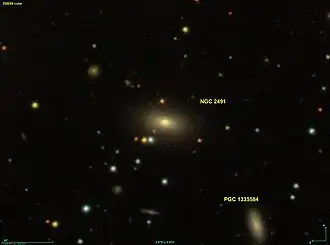NGC 2491
| NGC 2491 | |
|---|---|
 Sloan Digital Sky Survey of NGC 2491 | |
| Observation data (J2000 epoch) | |
| Constellation | Canis Minor |
| Right ascension | 07h 58m 27.37s |
| Declination | +07d 59m 01.74s |
| Redshift | 0.039290 |
| Heliocentric radial velocity | 18,476 km/s |
| Distance | 583 Mly (178.74 Mpc) |
| Apparent magnitude (V) | 14.8 |
| Apparent magnitude (B) | 15.6 |
| Surface brightness | 11.75 |
| Characteristics | |
| Type | S |
| Size | 130,000 ly |
| Apparent size (V) | 0.3' x 0.2' |
| Other designations | |
| PGC 22353, 2MASX J07582739+0759018, SDSS J075827.37+075901.7, CGCG 031-007, 2MASS J07582738+0759019, NPM1G+08.0123, LEDA 22353 | |
NGC 2491 is a spiral galaxy located in Canis Minor constellation.[1] It is located 580 million light-years from Earth and has an approximate diameter of 130,000 light-years.[2]
Details
NGC 2491 was discovered by American astronomer Lewis Swift on November 15, 1885.[3] Swift described it as extremely faint, small, with a round irregular shape, and a bright star to the west.[3] With a surface brightness of magnitude of 11.75, NGC 2491 is classified as a high surface brightness galaxy.[4]
References
- ^ "Revised NGC Data for NGC 2491". spider.seds.org. Retrieved 2024-04-23.
- ^ "Your NED Search Results". ned.ipac.caltech.edu. Retrieved 2024-04-23.
- ^ a b "New General Catalog Objects: NGC 2450 - 2499". cseligman.com. Retrieved 2024-04-23.
- ^ "Data from NGC and IC catalogue by Wolfgang Steinickle from NGC 2400-2499". astrovalleyfield.ca. Retrieved 2024-04-23.